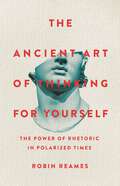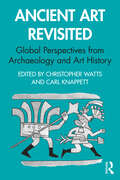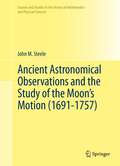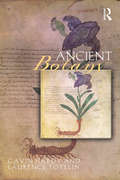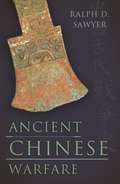- Table View
- List View
The Ancient Art of Thinking For Yourself: The Power of Rhetoric in Polarized Times
by Robin ReamesHow rhetoric—the art of persuasion—can help us navigate an age of misinformation, conspiracy theories, and political acrimony The discipline of rhetoric was the keystone of Western education for over two thousand years. Only recently has its perceived importance faded. In this book, renowned rhetorical scholar Robin Reames argues that, in today&’s polarized political climate, we should all care deeply about learning rhetoric. Drawing on examples ranging from the destructive ancient Greek demagogue Alcibiades to modern-day conspiracists like Alex Jones, Reames breaks down the major techniques of rhetoric, pulling back the curtain on how politicians, journalists, and &“journalists&” convince us to believe what we believe—and to talk, vote, and act accordingly. Understanding these techniques helps us avoid being manipulated by authority figures who don&’t have our best interests at heart. It also grants us rare insight into the values that shape our own beliefs. Learning rhetoric, Reames argues, doesn&’t teach us what to think but how to think—allowing us to understand our own and others&’ ideological commitments in a completely new way. Thoughtful, nuanced, and leavened with dry humor, The Ancient Art of Thinking for Yourself offers an antidote to our polarized, post-truth world.
Ancient Art Revisited: Global Perspectives from Archaeology and Art History
by Christopher Watts Carl KnappettAncient Art Revisited develops new perspectives on ancient art by weaving together diverse strands within archaeology and art history, exploring it through recent developments in archaeological theory. In order to foster dialogue among various subfields, contributors are drawn from a wide range of domains. Classical archaeology, Aegean prehistory, Near Eastern archaeology, Egyptology, Pre-Columbian South America, and North America are brought together to explore ancient art from multiscalar perspectives and through the lenses of entanglement theory, network thinking, assemblage theory, and other recent theoretical developments. Representing a new wave in research on ancient art, considering both the proximal and distributed operations of artworks, Ancient Art Revisited provides broad and inclusive coverage of ancient art and offers a cohesive approach to a fragmented area of study. This book will be suitable for archaeologists, anthropologists, and art historians wishing to understand the latest thinking on ancient art.
Ancient Art Revisited: Global Perspectives from Archaeology and Art History
by Christopher Watts Carl KnappettAncient Art Revisited develops new perspectives on ancient art by weaving together diverse strands within archaeology and art history, exploring it through recent developments in archaeological theory. In order to foster dialogue among various subfields, contributors are drawn from a wide range of domains. Classical archaeology, Aegean prehistory, Near Eastern archaeology, Egyptology, Pre-Columbian South America, and North America are brought together to explore ancient art from multiscalar perspectives and through the lenses of entanglement theory, network thinking, assemblage theory, and other recent theoretical developments. Representing a new wave in research on ancient art, considering both the proximal and distributed operations of artworks, Ancient Art Revisited provides broad and inclusive coverage of ancient art and offers a cohesive approach to a fragmented area of study. This book will be suitable for archaeologists, anthropologists, and art historians wishing to understand the latest thinking on ancient art.
Ancient Assyria: A Very Short Introduction (Very Short Introductions)
by Karen RadnerAssyria was one of the most influential kingdoms of the Ancient Near East. In this Very Short Introduction, Karen Radner sketches the history of Assyria from city state to empire, from the early 2nd millennium BC to the end of the 7th century BC. Since the archaeological rediscovery of Assyria in the mid-19th century, its cities have been excavated extensively in Iraq, Syria, Turkey and Israel, with further sites in Iran, Lebanon, and Jordan providing important information. The Assyrian Empire was one of the most geographically vast, socially diverse, multicultural, and multi-ethnic states of the early first millennium BC.Using archaeological records, Radner provides insights into the lives of the inhabitants of the kingdom, highlighting the diversity of human experiences in the Assyrian Empire. ABOUT THE SERIES: The Very Short Introductions series from Oxford University Press contains hundreds of titles in almost every subject area. These pocket-sized books are the perfect way to get ahead in a new subject quickly. Our expert authors combine facts, analysis, perspective, new ideas, and enthusiasm to make interesting and challenging topics highly readable.
Ancient Assyria: A Very Short Introduction (Very Short Introductions)
by Karen RadnerAssyria was one of the most influential kingdoms of the Ancient Near East. In this Very Short Introduction, Karen Radner sketches the history of Assyria from city state to empire, from the early 2nd millennium BC to the end of the 7th century BC. Since the archaeological rediscovery of Assyria in the mid-19th century, its cities have been excavated extensively in Iraq, Syria, Turkey and Israel, with further sites in Iran, Lebanon, and Jordan providing important information. The Assyrian Empire was one of the most geographically vast, socially diverse, multicultural, and multi-ethnic states of the early first millennium BC.Using archaeological records, Radner provides insights into the lives of the inhabitants of the kingdom, highlighting the diversity of human experiences in the Assyrian Empire. ABOUT THE SERIES: The Very Short Introductions series from Oxford University Press contains hundreds of titles in almost every subject area. These pocket-sized books are the perfect way to get ahead in a new subject quickly. Our expert authors combine facts, analysis, perspective, new ideas, and enthusiasm to make interesting and challenging topics highly readable.
The Ancient Assyrians: Empire and Army, 883–612 BC
by Mark HealyDrawing on 30 years of scholarship, this is a unique, richly illustrated history of the Ancient Assyrian Army and Empire. For the greater part of the period from the end of the 10th century to the 7th century BC, the Ancient Near East was dominated by the dynamic military power of Assyria. This book examines the empire that is now acknowledged as the first 'world' empire, and thus progenitor of all others. Fully illustrated in colour throughout, with photographs of artefacts, drawings and maps, it focuses on the Assyrian Army, the instrument that secured such immense conquests, now regarded by historians as being the most effective of pre-classical times. It was not only responsible for the creation of history's first independent cavalry arm, but also for the development of siege weapons later used by both Greece and Rome. There is a great deal of visual evidence showing how this army evolved over three centuries. During the rediscovery and excavation of the Assyrian civilisation in the mid-19th century, many wall reliefs and artefacts were recovered, and the enormous amount of research carried out by Assyriologists since that time has revealed the immense impact of the Assyrian Empire on history. Such has been the scale of archaeological discovery in more recent years that it is now possible to give the actual names of chariot/cavalry unit commanders. Drawing on this rich scholarship, and utilising the fantastic collections of museums around the world, Mark Healy presents a unique new history of this fascinating army and empire.
The Ancient Assyrians: Empire and Army, 883–612 BC
by Mark HealyDrawing on 30 years of scholarship, this is a unique, richly illustrated history of the Ancient Assyrian Army and Empire. For the greater part of the period from the end of the 10th century to the 7th century BC, the Ancient Near East was dominated by the dynamic military power of Assyria. This book examines the empire that is now acknowledged as the first 'world' empire, and thus progenitor of all others. Fully illustrated in colour throughout, with photographs of artefacts, drawings and maps, it focuses on the Assyrian Army, the instrument that secured such immense conquests, now regarded by historians as being the most effective of pre-classical times. It was not only responsible for the creation of history's first independent cavalry arm, but also for the development of siege weapons later used by both Greece and Rome. There is a great deal of visual evidence showing how this army evolved over three centuries. During the rediscovery and excavation of the Assyrian civilisation in the mid-19th century, many wall reliefs and artefacts were recovered, and the enormous amount of research carried out by Assyriologists since that time has revealed the immense impact of the Assyrian Empire on history. Such has been the scale of archaeological discovery in more recent years that it is now possible to give the actual names of chariot/cavalry unit commanders. Drawing on this rich scholarship, and utilising the fantastic collections of museums around the world, Mark Healy presents a unique new history of this fascinating army and empire.
Ancient Astrology (Sciences of Antiquity)
by Tamysn BartonAn account of astrology from its beginnings in Mesopotamia, focusing on the Greco-Roman world, Ancient Astrology examines the theoretical development and changing social and political role of astrology.
Ancient Astrology (Sciences of Antiquity)
by Tamysn BartonAn account of astrology from its beginnings in Mesopotamia, focusing on the Greco-Roman world, Ancient Astrology examines the theoretical development and changing social and political role of astrology.
Ancient Astronomical Observations and the Study of the Moon’s Motion (Sources and Studies in the History of Mathematics and Physical Sciences)
by John M. SteeleThe discovery of a gradual acceleration in the moon’s mean motion by Edmond Halley in the last decade of the seventeenth century led to a revival of interest in reports of astronomical observations from antiquity. These observations provided the only means to study the moon’s ‘secular acceleration’, as this newly-discovered acceleration became known. This book contains the first detailed study of the use of ancient and medieval astronomical observations in order to investigate the moon’s secular acceleration from its discovery by Halley to the establishment of the magnitude of the acceleration by Richard Dunthorne, Tobias Mayer and Jérôme Lalande in the 1740s and 1750s. Making extensive use of previously unstudied manuscripts, this work shows how different astronomers used the same small body of preserved ancient observations in different ways in their work on the secular acceleration. In addition, this work looks at the wider context of the study of the moon’s secular acceleration, including its use in debates of biblical chronology, whether the heavens were made up of æther, and the use of astronomy in determining geographical longitude. It also discusses wider issues of the perceptions and knowledge of ancient and medieval astronomy in the early-modern period. This book will be of interest to historians of astronomy, astronomers and historians of the ancient world.
Ancient Boats in North-West Europe: The Archaeology of Water Transport to AD 1500
by Sean McgrailAt last a paperback edition of this standard work on marine archaeology. Séan McGrail's study received exceptional critical acclaim when it was first published in hardback in 1987 and it is now revised and published in paperback for the first time. Professor McGrail provides an authoritative survey of water transport across Northern Europe from the Late Palaeolithic to the later Middle Ages, using evidence of excavations, but also documentary sources, iconographic and ethnographic evidence. In the process he answers such key questions as How were these boats built? What sort of environment were they used in? What speeds could they achieve? and how were they navigated?
Ancient Boats in North-West Europe: The Archaeology of Water Transport to AD 1500 (Longman Archaeology Series)
by Sean McgrailAt last a paperback edition of this standard work on marine archaeology. Séan McGrail's study received exceptional critical acclaim when it was first published in hardback in 1987 and it is now revised and published in paperback for the first time. Professor McGrail provides an authoritative survey of water transport across Northern Europe from the Late Palaeolithic to the later Middle Ages, using evidence of excavations, but also documentary sources, iconographic and ethnographic evidence. In the process he answers such key questions as How were these boats built? What sort of environment were they used in? What speeds could they achieve? and how were they navigated?
Ancient Botany (Sciences of Antiquity)
by Gavin Hardy Laurence TotelinGavin Hardy and Laurence Totelin have brought together their botanical and historical knowledge to produce this unique overview of ancient botany. It examines all the founding texts of botanical science, such as Theophrastus' Enquiry into Plants, Dioscorides' Materia Medica, Pliny the Elder's Natural History, Nicolaus of Damascus' On Plants, and Galen' On Simple Remedies, but also includes lesser known texts ranging from the sixth century BCE to the seventh century CE, as well as some material evidence. The authors adopt a thematic approach rather than a chronological one, considering important issues such as the definition of a plant, nomenclature, classifications, physiology, the link between plants and their environment, and the numerous usages of plants in the ancient world. The book also takes care to place ancient botany in its historical, social and economic context. The authors have explained all technical botanical terms and ancient history notions, and as a result, this work will appeal to historians of ancient science, medicine and technology; classicists; and botanists interested in the history of their discipline.
Ancient Botany (Sciences of Antiquity)
by Gavin Hardy Laurence TotelinGavin Hardy and Laurence Totelin have brought together their botanical and historical knowledge to produce this unique overview of ancient botany. It examines all the founding texts of botanical science, such as Theophrastus' Enquiry into Plants, Dioscorides' Materia Medica, Pliny the Elder's Natural History, Nicolaus of Damascus' On Plants, and Galen' On Simple Remedies, but also includes lesser known texts ranging from the sixth century BCE to the seventh century CE, as well as some material evidence. The authors adopt a thematic approach rather than a chronological one, considering important issues such as the definition of a plant, nomenclature, classifications, physiology, the link between plants and their environment, and the numerous usages of plants in the ancient world. The book also takes care to place ancient botany in its historical, social and economic context. The authors have explained all technical botanical terms and ancient history notions, and as a result, this work will appeal to historians of ancient science, medicine and technology; classicists; and botanists interested in the history of their discipline.
Ancient Canaan and Israel: New Perspectives (Understanding Ancient Civilizations)
by Jonathan M. GoldenIt's the cradle of civilization, the wellspring of three of the world's most powerful faiths, a place where vestiges of the ancient past remain vibrantly alive today—but what do we really know about the day-to-day lives and defining culture of the people of Israel and Canaan?Ancient Canaan and Israel takes readers beyond the scriptural portrayals of the region and into the everyday lives of Canaanites and Israelites. It draws on recently discovered archaeological evidence and fresh interpretations of biblical and extrabiblical texts to show how archaeologists and other researchers reconstruct the many facets of these civilizations—political, geographic, social, economic, religious, technological, and aesthetic.For experienced scholars or enthusiastic newcomers, it is an enlightening portrayal of the people and the land of Canaan and Israel, which traces many well-known spiritual and cultural traditions back to their ancient roots. It is also an objective introduction to a number of much-debated topics, such as the fate of the Canaanite cultures, the origins of the Israelites, and the historical accuracy of the Bible.
Ancient China: A History
by John S. Major Constance A. CookAncient China: A History surveys the East Asian Heartland Region – the geographical area that eventually became known as China – from the Neolithic period through the Bronze Age, to the early imperial era of Qin and Han, up to the threshold of the medieval period in the third century CE. For most of that long span of time there was no such place as "China"; the vast and varied territory of the Heartland Region was home to many diverse cultures that only slowly coalesced, culturally, linguistically, and politically, to form the first recognizably Chinese empires. The field of Early China Studies is being revolutionized in our time by a wealth of archaeologically recovered texts and artefacts. Major and Cook draw on this exciting new evidence and a rich harvest of contemporary scholarship to present a leading-edge account of ancient China and its antecedents. With handy pedagogical features such as maps and illustrations, as well as an extensive list of recommendations for further reading, Ancient China: A History is an important resource for undergraduate and postgraduate courses on Chinese History, and those studuing Chinese Culture and Society more generally.
Ancient China: A History
by John S. Major Constance A. CookAncient China: A History surveys the East Asian Heartland Region – the geographical area that eventually became known as China – from the Neolithic period through the Bronze Age, to the early imperial era of Qin and Han, up to the threshold of the medieval period in the third century CE. For most of that long span of time there was no such place as "China"; the vast and varied territory of the Heartland Region was home to many diverse cultures that only slowly coalesced, culturally, linguistically, and politically, to form the first recognizably Chinese empires. The field of Early China Studies is being revolutionized in our time by a wealth of archaeologically recovered texts and artefacts. Major and Cook draw on this exciting new evidence and a rich harvest of contemporary scholarship to present a leading-edge account of ancient China and its antecedents. With handy pedagogical features such as maps and illustrations, as well as an extensive list of recommendations for further reading, Ancient China: A History is an important resource for undergraduate and postgraduate courses on Chinese History, and those studuing Chinese Culture and Society more generally.
Ancient Chinese Academy, Confucianism, and Society I: The Rise and Growth
by Xiao YongmingAs the first volume of a two-volume set that studies the ancient Chinese academy from a socio-cultural perspective, this title explores the history of the academy and its relationship with the development of Confucianism in the Song, Yuan, and Ming dynasties. Inaugurated in the Tang dynasty and eventually abolished in the late Qing dynasty, the academy, as a unique cultural and educational organization in Chinese history, exerted extensive and profound influences on ancient Chinese culture, politics, and social life. The book first revisits the inception and development of the academy by anaylzing the socio-cultural context and different driving forces including social mentality, print culture, education systems, and so on. It then examines the reciprocity and thriving relationships between the academy and Neo-Confucianism in the Song and Yuan dynasties and Yangming School of Mind in the Ming dynasty. The title will be a useful reference for scholars, students, and general readers interested in cultural history, intellectual history, and educational history of ancient China and especially the Chinese academy culture.
Ancient Chinese Academy, Confucianism, and Society I: The Rise and Growth
by Xiao YongmingAs the first volume of a two-volume set that studies the ancient Chinese academy from a socio-cultural perspective, this title explores the history of the academy and its relationship with the development of Confucianism in the Song, Yuan, and Ming dynasties. Inaugurated in the Tang dynasty and eventually abolished in the late Qing dynasty, the academy, as a unique cultural and educational organization in Chinese history, exerted extensive and profound influences on ancient Chinese culture, politics, and social life. The book first revisits the inception and development of the academy by anaylzing the socio-cultural context and different driving forces including social mentality, print culture, education systems, and so on. It then examines the reciprocity and thriving relationships between the academy and Neo-Confucianism in the Song and Yuan dynasties and Yangming School of Mind in the Ming dynasty. The title will be a useful reference for scholars, students, and general readers interested in cultural history, intellectual history, and educational history of ancient China and especially the Chinese academy culture.
Ancient Chinese Academy, Confucianism, and Society II: Politics and Culture
by Xiao YongmingAs the second volume of a two-volume set that studies the ancient Chinese academy from a socio-cultural perspective, this title investigates the multifaceted roles and political and cultural significance of the academy. Inaugurated in the Tang dynasty and eventually abolished in the late Qing dynasty, the academy, as a unique cultural and educational organization in the Chinese history, exerted extensive and profound influence on the ancient Chinese culture, politics, and social life. This title first discusses the state control of the academy and how it functions in social governance, then examines the sacrificial ritual of the academy and its influence on education, enculturation, Confucian orthodoxy, and intellectual ethos, and finally elaborates on the academy's role in enriching the regional cultures in terms of local cultural undertakings and talent cultivation. The title will be a useful reference for scholars, students, and general readers interested in cultural history, intellectual history, and educational history of ancient China and especially the Chinese academy culture.
Ancient Chinese Academy, Confucianism, and Society II: Politics and Culture
by Xiao YongmingAs the second volume of a two-volume set that studies the ancient Chinese academy from a socio-cultural perspective, this title investigates the multifaceted roles and political and cultural significance of the academy. Inaugurated in the Tang dynasty and eventually abolished in the late Qing dynasty, the academy, as a unique cultural and educational organization in the Chinese history, exerted extensive and profound influence on the ancient Chinese culture, politics, and social life. This title first discusses the state control of the academy and how it functions in social governance, then examines the sacrificial ritual of the academy and its influence on education, enculturation, Confucian orthodoxy, and intellectual ethos, and finally elaborates on the academy's role in enriching the regional cultures in terms of local cultural undertakings and talent cultivation. The title will be a useful reference for scholars, students, and general readers interested in cultural history, intellectual history, and educational history of ancient China and especially the Chinese academy culture.
Ancient Chinese Thought, Modern Chinese Power
by Yan Xuetong Daniel A. Bell Sun Zhe Edmund RydenThe rise of China could be the most important political development of the twenty-first century. What will China look like in the future? What should it look like? And what will China's rise mean for the rest of world? This book, written by China's most influential foreign policy thinker, sets out a vision for the coming decades from China's point of view. In the West, Yan Xuetong is often regarded as a hawkish policy advisor and enemy of liberal internationalists. But a very different picture emerges from this book, as Yan examines the lessons of ancient Chinese political thought for the future of China and the development of a "Beijing consensus" in international relations. Yan, it becomes clear, is neither a communist who believes that economic might is the key to national power, nor a neoconservative who believes that China should rely on military might to get its way. Rather, Yan argues, political leadership is the key to national power, and morality is an essential part of political leadership. Economic and military might are important components of national power, but they are secondary to political leaders who act in accordance with moral norms, and the same holds true in determining the hierarchy of the global order. Providing new insights into the thinking of one of China's leading foreign policy figures, this book will be essential reading for anyone interested in China's rise or in international relations. In a new preface, Yan reflects on his arguments in light of recent developments in Chinese foreign policy, including the selection of a new leader in 2012.
Ancient Chinese Thought, Modern Chinese Power (PDF)
by Yan Xuetong Daniel A. Bell Sun Zhe Edmund RydenThe rise of China could be the most important political development of the twenty-first century. What will China look like in the future? What should it look like? And what will China's rise mean for the rest of world? This book, written by China's most influential foreign policy thinker, sets out a vision for the coming decades from China's point of view. In the West, Yan Xuetong is often regarded as a hawkish policy advisor and enemy of liberal internationalists. But a very different picture emerges from this book, as Yan examines the lessons of ancient Chinese political thought for the future of China and the development of a "Beijing consensus" in international relations. Yan, it becomes clear, is neither a communist who believes that economic might is the key to national power, nor a neoconservative who believes that China should rely on military might to get its way. Rather, Yan argues, political leadership is the key to national power, and morality is an essential part of political leadership. Economic and military might are important components of national power, but they are secondary to political leaders who act in accordance with moral norms, and the same holds true in determining the hierarchy of the global order. Providing new insights into the thinking of one of China's leading foreign policy figures, this book will be essential reading for anyone interested in China's rise or in international relations. In a new preface, Yan reflects on his arguments in light of recent developments in Chinese foreign policy, including the selection of a new leader in 2012.
Ancient Chinese Warfare
by Ralph D. SawyerThe history of China is a history of warfare. Rarely in its 3,000-year existence has the country not been beset by war, rebellion, or raids. Warfare was a primary source of innovation, social evolution, and material progress in the Legendary Era, Hsia dynasty, and Shang dynasty--indeed, war was the force that formed the first cohesive Chinese empire, setting China on a trajectory of state building and aggressive activity that continues to this day.In Ancient Chinese Warfare, a preeminent expert on Chinese military history uses recently recovered documents and archaeological findings to construct a comprehensive guide to the developing technologies, strategies, and logistics of ancient Chinese militarism. The result is a definitive look at the tools and methods that won wars and shaped culture in ancient China.
Ancient Christians and the Power of Curses: Magic, Aesthetics, and Justice
by null Laura Salah NasrallahAncient Christians and their non-Christian contemporaries lived in a world of 'magic.' Sometimes, they used curses as ritual objects to seek justice from gods and other beings; sometimes, they argued against them. Curses, and the writings of those who polemicized against curses, reveal the complexity of ancient Mediterranean religions, in which materiality, poetics, song, incantation, and glossolalia were used as technologies of power. Laura Nasrallah's study reframes the field of religion, the study of the Roman imperial period, and the investigation of the New Testament and ancient Christianity. Her approach eschews disciplinary aesthetics that privilege the literature and archaeological remains of elites, and that defines curses as magical materials, separable from religious ritual. Moreover, Nasrallah's imaginative use of art and 'research creations' of contemporary Black painters, sculptors, and poets offer insights for understanding how ancient ritual materials embedded into art work intervene into the present moment and critique injustice.
